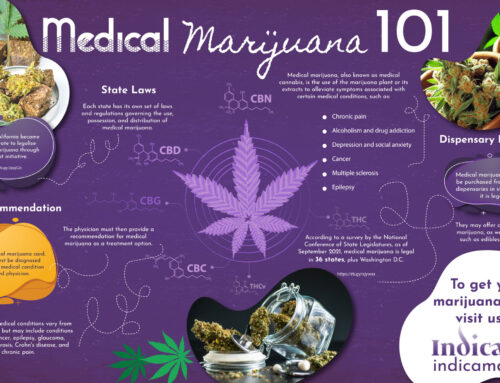Muscle spasms are one of the most common reasons for prescription of medical marijuana. Previous studies showed a positive correlation of marijuana treatment for relieving the spasms, often showing significant improvement in human and animal trials.
Research into the treatment of spasticity through marijuana was abandoned however, mostly because of the negative news surrounding the drug. With the recent increase in its adoption, the research has been picked up by a number of scientific and medical research groups.
There are two strong cannabinoids found in marijuana, THC and CBD. Both have long been associated with pain relief and relaxing muscles. Researchers claim that there is strong evidence of reduction in muscle tremors and spasticity after Marijuana consumption.
Due to the strong evidence surrounding treatment of spasms with marijuana, a number of the U.S. states have legalized prescription of marijuana for treatment of spasms. These include the states of New York and California where you can legally purchase Marijuana for controlling the symptoms of spasms caused by Multiple Sclerosis, brain and spinal cord injury or Cerebral Palsy.
In this article, we examine the causes, symptoms and treatments available for the condition of spasticity and the evidence behind the effectiveness of Marijuana in controlling the disorder.
What is Spasticity?
Spasticity is a disorder of the muscles that results in stiff and rigid muscles. The condition is usually brought on by multiple sclerosis but can also be caused by imbalances in the nervous system.
The muscles in our body normally maintain a level of muscle tension that enables us to stand up straight. If the tension in the muscle increases too much, they become stiff and spastic. When muscles become rigid like this it becomes painful to move them and the range of motion also decreases.
Spastic patients experience involuntary muscle movement, usually in the torso and limbs. There are three types of muscle groups that are affected by spasticity:
- Flexors: These muscles allow the limbs to bend at the joints.
- Extensors: These muscles let the limbs extend and become outstretched.
- Adductors: These are lateral muscles that let the limbs close together with the body’s midline.
Symptoms of Spasticity
People affected by spasticity show a number of symptoms which include:
- Hypertonicity: a state of muscles where they are at abnormally high tension
- Muscle movements that are involuntary. These are usually in the form of muscle spasms which can be in a series or isolated.
- Spasticity also causes highly reflexive movements in tendons and connecting muscles that control the limbs.
- Patients of Spasticity also suffer from mild to severe pain in the muscles when the muscles contract and become rigid.
- Spasticity can also decrease the functional ability of the limbs and slows down movement.
- Muscle contractions in the back can also cause a hunched or tilted posture.
- In some cases, tension in the muscles also affects walking and even results in speech impairment.
- Spasticity can also lead to deformities in joints and bones in children.
- Spasticity can also cause insomnia due to pain and stiffness while sleeping.
- Patients of spasticity can also lose control of bowel movement.
Causes of Spasticity
Spasticity is caused by a number of existing medical conditions such as Multiple Sclerosis, spinal cord injury, traumatic brain injury, cerebral palsy and stroke. The most common cause is due to an imbalance of signals from the nervous system to the muscles.
- Multiple Sclerosis
In Multiple Sclerosis, the nerve cells of the spinal cord lose their protective covering made from a protein called myelin. The exposed nerve cells get damaged over time. Since nerve cells act as the pathway for messages between the brain and the muscles, any damage to the nervous system causes the messages from the brain to become distorted.
The muscle groups controlled by the nerves contract and stiffen involuntarily, when they should not. Over a period of time, the affected person progressively loses precise motor control, coordination of movement and suffers from painful contractions.
- Cerebral Palsy
Cerebral palsy (CP) is a neurological disorder that can also lead to spasticity. CP occurs due to malformation or injury to the brain in children. Most people with CP are born with the condition but some acquire it later due to head injury.
In CP, spasticity is caused by damage to the motor cortex, a part of the brain that is responsible for movement control. This causes impairment in movement. Patients may get affected with partial stiffness in upper or lower limbs or problems with speech and standing upright.
- Brain or Spinal Cord Injury
Spasticity can also result from an injury to the brain or spinal cord. The brain sends signals to the muscles to contract or relax through the spinal cord. Any damage to the brain or the nervous system causes a breakdown in the network and scrambles the message.
Research shows that around 50% of brain injury patients develop spasticity. The type of spasticity varies for patients depending on the area of damage and could be in the range of mild to severe.
Spasticity Treatments
People suffering from spasticity are treated by a specialized team of doctors. The disorder is not fatal in itself but sudden onset of spasms could be dangerous for the patient when driving or swimming.
Treatments for spasticity include prescription and injected medication, physiotherapy, surgery, rehabilitation therapy, casting and splinting as well as intrathecal medication which is directly injected into the patient with a pump.
Is Marijuana an Effective Treatment for Spasticity?
When it comes to using Marijuana for spasticity treatment, there are pros and cons and patients should be aware of both.
Researchers from the Movement Disorder Center of Neurology at Charles University reported that more than 45% of patients at the department that took Marijuana for treatment noted that they received positive benefits from taking Cannabis with their treatment.
The Journal of Cannabis Therapeutics noted that some patients suffering from spasms due to Multiple Sclerosis reported relief of joint pain and spasms after a few puffs of the drug. The Journal noted that this shows a very rapid absorption of the drug into the nervous system for quick relief.
The ASA association claims that numerous surveys, double-blind trials and case studies have shown that CBD can demonstrably lessen the spasms and symptoms of Multiple Sclerosis.
On the other hand, some groups have noted that the claims of Marijuana treatment for Multiple Sclerosis and spasms are anecdotal at best and harmful at worst. The US Institute of Medicine noted that the regular use of Marijuana could be detrimental although the institute was in support of investigative research into the drug.
The U.S. National Multiple Sclerosis Society (NMSS) holds the position that Marijuana is not an effective treatment for MS and long term usage could lead to adverse side effects. The society recommends usage of FDA approved drugs like Baclofen and Tizanidine for treatment.
Both these drugs act as suppressants for the central nervous system and relax skeletal muscles, an effect similar to medical marijuana consumption.
Research and Studies on Marijuana Treatment for Spasticity
Baclofen and Tizanidine are both known to relieve spasticity. However it has been noted that the effects are only partial and some patients did not experience any relaxation in the muscles. Both these drugs are sedatives and cause drowsiness, muscle weakness and dryness in the mouth and throat.
Researchers are starting to look into CBD and THC for their effectiveness in relieving spasms. One clinical study examined the effects of THC on patients suffering from spasms due to MS and unaffected individuals. The results were interesting and showed that while MS patients reported relief and believed their symptoms had improved after taking the drug, their posture and balance were actually noted to have decreased.
In a separate study of three simultaneous trials, researchers noted that THC improved the symptoms for some of the patients, although it was not universally effective for everyone.
A similar study showed that a patient suffering from spasms showed significant improvement in handwriting after taking the drug.
One single patient was tested using nabilone, a drug that is synthetically produced and has a similar effect as THC on cellular receptors. The drug was shown to have a positive impact in improving the symptoms of spasticity for the patient.
Medical Marijuana Therapy for Spasticity
Researchers have noted that spasms are caused in patients for different reasons. The underlying reason for spasms could be due to an injury to the brain and spinal cord or degradation of the nervous system due to onset of Multiple Sclerosis. This makes it unlikely that the same drug could work for people suffering from spasms due to completely different disorders.
However, both types of spasticity could be treated with the same drug to improve symptoms and relieve pain, muscle spasms and rigidity.
While some of the currently available medication has the side effect of muscle weakening, Marijuana therapy for the treatment of spasticity can also cause side effects.
Researchers recommend using Marijuana therapy in moderation. Extended use of the drug without prescription is discouraged. In order to get the correct prescription for your specific condition of spasms, you should consult an experience Marijuana doctor.







Leave A Comment
You must be logged in to post a comment.